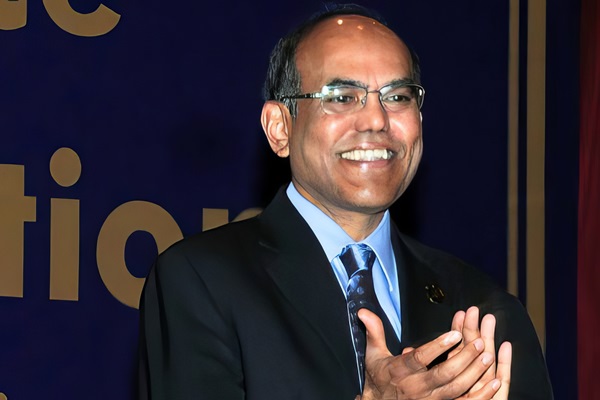.png)
India’s Fiscal Fault Lines Risk Derailing Viksit Bharat Vision: Subbarao
The former RBI Governor warns that weak state finances, freebies, and Centre–state rifts could upend India’s journey to becoming a truly developed economy.


Kalyan Ram, a financial journalist, co-founded Cogencis and now leads BasisPoint Insight.
June 6, 2025 at 3:30 AM IST
India’s quest for Viksit Bharat, or developed nation status by 2047, may be derailed not by a lack of ambition or growth but by festering disquiet among its most advanced states.
In an unvarnished interview with BasisPoint Insight, former Reserve Bank of India Governor Duvvuri Subbarao warns that a widening political and fiscal gulf between the Centre and southern states threatens to erode the foundations of cooperative federalism, just when it is most needed.
Southern states, he notes, have delivered strongly on growth, governance, social indicators, and public finance. Yet, they now face the double blow of subsidising poorer states through central transfers, while potentially losing parliamentary representation after the next delimitation exercise.
“It’s a double blow—less money and less voice,” Subbarao says, arguing that this structural imbalance, if left unaddressed, could deepen the North–South divide into a full-blown legitimacy crisis.
That isn’t the only fault line. Subbarao highlights a glaring divergence in fiscal conduct between the Centre and the states. While New Delhi has focused on transparency, consolidation, and capital expenditure, many state governments, he says, have regressed—masking deficits and indulging in fiscally reckless freebies. “India is one fiscal entity. Profligacy in one state affects the whole,” he cautions.
What’s more alarming, he says, is the lack of any effective institutional checks.
The Reserve Bank is just a debt manager; it cannot intervene. The Election Commission’s influence ends after polling day. The Comptroller and Auditor General arrives after the damage is done. And the Centre, though constitutionally empowered to set borrowing conditions, has shied away for fear of political backlash.
The way forward, according to Subbarao, lies not in legal reform but political statesmanship.
Only the Centre, he argues, can coalesce a national consensus and draft a code of fiscal conduct. Without this, competitive populism and federal friction will continue to impair India’s macroeconomic stability.
Most importantly, Subbarao insists that growth alone will not make India a developed country. Institutions matter. “Saudi Arabia is rich, but no one calls it developed,” he says, invoking Francis Fukuyama’s criteria for modern states—rule of law, a strong state, and accountable governance. Viksit Bharat, in this telling, requires more than just GDP.
It requires genuine political maturity.
This is the concluding part of the four-part interview themed “India 2047: Raising the Game for a Developed Future.”
Edited excerpts:
Q: Let me now turn to a subject you've studied closely — state government finances.
While the central government has shown fiscal discipline and stuck to its consolidation path, possibly in pursuit of a ratings upgrade, state finances appear far more precarious. Investors and rating agencies assess the country’s fiscal health in a consolidated manner. Are the Centre and states moving in different directions when it comes to fiscal policy?
A: To some extent, yes. As you noted, over the last few years, the central government has demonstrated a credible commitment to fiscal consolidation. It has also cleaned up its books, leading to greater transparency. There are no hidden expenditures or off-balance-sheet liabilities. In that sense, the Centre has moved forward.
State governments, disappointingly, have not kept pace. In fact, some have even regressed.
We must recognise that India is one fiscal entity. Rating agencies don’t assess the Centre in isolation; they look at the combined fiscal stance of the Union and the states. Fiscal indiscipline in even a single state can have system-wide repercussions. So, it’s entirely appropriate for rating agencies to consider the aggregate position, and that means we must place greater emphasis on fiscal consolidation and responsibility at the state level too.
Consider the 60-40 picture I often refer to. If you look at the combined tax revenues, the Centre collects around 60% while the states collect about 40%. But on the expenditure side, states account for nearly 60% of total spending, while the Centre handles just 40%.
This fiscal asymmetry means that the collective stance of the states — their debt levels and the quality of their spending — significantly influences our overall fiscal and macroeconomic stability.
Q: States also seem to be in some sort of competition with each other over freebies. You’ve spoken about this recently. How can this be reined in? Is there a mechanism that can help, and through what forum? Is this getting out of hand?
A: I think it is getting out of hand. There is competitive populism at play. Political parties want to win elections, they make promises, and people respond to those promises. This results in an assault on public finances.
But let me begin by saying that in a low-income country like ours, where hundreds of millions struggle for daily livelihoods, it is imperative for governments—both at the Centre and in the states—to provide some transfer payments. These are not only necessary, but also desirable. However, they must be kept within limits.
Why? Because, as we discussed earlier, many of these freebies are not being funded through revenue but through borrowing. It’s like a household borrowing to host a party, go on a vacation, or organise a wedding. It is unsustainable.
That’s the fiscal situation states are in. Freebies are being funded through debt. This means we are borrowing today for current consumption but passing on the burden of repayment to our children. We need to be more responsible, more restrained.
Also, are freebies the best use of public money? And what freebie gives the best mileage for the limited amount of money? Take, for example, free bus rides for women—which I personally believe is desirable as indeed many people do. But have we ever asked: is it better to give free bus rides, or use the same money to invest in quality education for girls? Which will serve the cause of women better? We haven’t asked that question.
It’s important to reflect on that. Like Mao said, should you give a person a fish every day, or teach them how to fish? I believe every freebie should be subjected to such scrutiny.
Now, coming to your core question—who or what can restrain this?
Some people say the Reserve Bank should take on this responsibility. The RBI can’t do it; it’s just a debt manager. It can’t restrain state governments—borrowing and spending are sovereign decisions. Some say the Election Commission take on the mantle. The Commission can, at best, ask for disclosure of the fiscal burden of promises during an election campaign. But it has no control over governments once elected.
People talk about the CAG, but the audit process is retrospective by its very nature. The CAG comes into the picture much after the sin has been committed. So, there are no real formal restraining mechanisms in place.
Can the Centre control the states?
Technically, yes. When the Centre grants permission to states to borrow, the Constitution allows it to impose conditions while giving approval. But no central government, irrespective of party, has invoked this provision to impose conditions — and quite wisely so — because of the political complexities involved.
So, what’s the solution?
In my view, we need a political consensus. Because of competitive politics, no state government will take the lead. No political party, not even the presently dominant BJP, will do this on its own. The Centre must take the initiative, convene all state governments and work towards a building consensus.
Just two days ago, we had a NITI Aayog meeting chaired by the Prime Minister, with all state governments in attendance. But from what I’ve seen in the media, this issue wasn’t even discussed.
That’s disappointing, because I believe this is an important matter—one that calls for agreement across party lines and between the Centre and the states. We need a code of conduct to rein in fiscal populism.
Q: Do you think the Finance Commission could be tasked with addressing this issue? Could its terms of reference be broadened to take this on?
A: Technically, it’s possible. But the Finance Commission is not a political body. Freebies, on the other hand, are an intensely political issue. To expect a non-political institution to resolve a deeply political problem in a democracy as vigorous and complex as ours is, I believe, mistaken.
This needs to be resolved through political consensus. That’s the only way to address the problem meaningfully.
Q: You recently gave a speech in which you challenged the notion that fiscal federalism is inherently biased against the states. Could you elaborate on that?
A: Yes. The common view—especially among people who have only a peripheral understanding of how fiscal federalism works—is that states are short-changed. That all the taxation powers rest with the Centre, that expenditure control lies with the Centre, and that states lack any real autonomy. I believe that view is misinformed, and I can offer several illustrations.
First, there’s the 60-40 pattern I mentioned earlier. States account for as much as 60% of combined public expenditure. In a democracy, political clout flows from spending authority. So, if states control 60% of total expenditure, they enjoy substantial power. This 60% figure is actually higher than what we see in many large federal countries—Australia, Canada, and even the United States.
Second, states today have much greater autonomy over how they spend their money. Earlier, under the Planning Commission model, we had central plans and state plans. The Centre largely dictated how plan funds should be spent. That’s no longer the case. With the Planning Commission abolished, states have more autonomy and a larger share of untied transfers from the Centre.
States in India can also borrow. Even though the Constitution allows the Centre to impose conditions on such borrowing, successive governments have refrained from doing so. As a result, states are able to borrow unconditionally—and often at rates lower than what they might otherwise command—because there is a market perception, albeit incorrect, that the Centre implicitly guarantees state debt.
The Centre does not guarantee state borrowings. But the perception persists, which helps states access funds more cheaply. In many other countries, states are not even allowed to borrow. For example, in the United States, states are required to balance their budgets. They can borrow only for specific capital projects.
In contrast, Indian states have the freedom to borrow and to choose how they spend those borrowed funds—including on recurring expenditure and even on freebies. So, I would argue that states in India enjoy a much larger share of public resources and much greater freedom on how they are deployed.
That’s why the notion that Centre–state fiscal relations are skewed against the states does not accord with the ground picture.
Let me also touch on GST, since this often comes up as a fault line in fiscal federalism. One of the standard arguments is that with the introduction of GST, states have lost their sovereignty—their power to raise taxes. That is true to an extent. But it's not just the states that ceded power; the Centre did too.
GST rates are now set by the GST Council, where both the Centre and the states are represented. So, sovereignty has been shared, not taken away. I believe GST is a good reform. It's good for the Centre, it's good for the states, and it's good for the country as a whole.
Q: Sir, one more question. Is there any way the central government can exert pressure or apply some mechanism to ensure that states exercise control over their spending?
A: The only constitutional or statutory mechanism available to the central government is the power to restrict state borrowing under Article 293 of the Constitution. It stipulates that states, as long as they are indebted to the Centre, require the Centre’s permission to borrow from the market. And the reality is that no state in India is likely to be free of debt to the Centre for the next 50 years.
So, in principle, the Centre has control over states’ borrowing. In practice, states enjoy virtual freedom since the Centre has historically refrained from imposing any conditions while giving permission for borrowing.
The reason is political. In today’s highly polarised environment, such actions are likely to be seen as politically motivated interference.
That leaves only one effective check—and that’s the people. Ultimately, accountability must be to the people. The only organ that can truly hold states accountable is an informed public.
That’s why I keep emphasising the importance of public awareness. There is a strong case for making budget documents more accessible—translate them to a light language that people can understand. Not in dense volumes filled with technical jargon, but in clear, simple terms that ordinary people can engage with.
Only when people are well-informed about how public funds are being raised and spent can they make considered judgments and demand accountability. That, in turn, will help promote greater fiscal responsibility.
Q: You’ve spoken earlier about the need for cooperative federalism, but there increasingly seems to be a widening divide between some southern state governments and the Centre. The language issue is also becoming more prominent. And then there’s the ongoing friction around fiscal federalism. Is this becoming a bigger problem than it ought to be? What’s the way forward?
A: I think the problem is getting larger by the day. As you rightly mentioned, there are several fault lines, including central resource transfers, language, the upcoming delimitation exercise, and more recently, the role of governors in restraining state governments. These issues are becoming deeply polarised, especially in the current political climate.
At a broader level, over the last 10 to 15 years, we’ve seen a slow but clear emergence of a North–South divide.
Southern states have done well in terms of growth, investment, infrastructure, health, education, governance, and rule of law. But when it comes to resource-sharing, the federal structure inevitably involves some cross-subsidisation from richer to poorer states. That is both appropriate and necessary.
Today, states like Tamil Nadu and Karnataka receive less than ₹1 from the central pool for every rupee they contribute in taxes. On the other hand, states like Bihar and Uttar Pradesh receive more than ₹1 for every rupee they contribute. This is typically how redistribution works in a federation.
The question, however, is whether we are reaching the limits of this arrangement.
Now overlay that with the impending delimitation exercise, which, if implemented after the next census as per current law, would reduce the parliamentary representation of southern states relative to the north. So, they would be asked to continue subsidising other states, even as their political voice in Parliament is diminished.
That’s a double blow, less money back, and less power.
When you add to those fault lines the role of governors and the language issue, the tension becomes quite acute. These problems cannot be solved through ordinary political processes. They require real statesmanship, not just at the Centre, but across both levels of government.
Q: Can we realistically achieve Viksit Bharat without addressing these Centre–state tensions?
A: I don’t believe we can. It is very appropriate that the Prime Minister has spoken about the Centre and states working together to achieve the vision of Viksit Bharat. According to media reports, several chief ministers also shared their own plans at the recent NITI Aayog meeting. All that is welcome. But we now need to move from declarations to action. To become a developed country, coordination between the Centre and states is not just desirable, it is essential.
Consider the post-1991 first-generation reforms, such as those in trade, finance, and investment. All of them were in domains controlled exclusively by the central government. Those reforms could be pushed through without consulting the states.
But today, the reforms we need, what we call second-generation reforms, are in areas like land, labour, taxation, and foreign investment. These are concurrent or state subjects. They require not just cooperation, in many cases they require the explicit consent of the states.
So, unless the Centre and states act in concert and with genuine synergy, the vision of Viksit Bharat will remain aspirational.
Q: And finally, your concluding thoughts. Is simply targeting high growth enough to become a developed country?
A: No, targeting growth alone is not sufficient. Yes, we must aim for 8% or higher growth. Without that, we won’t achieve the income levels associated with developed countries.
But being rich is not the same as being developed. Saudi Arabia is a rich country. But no one would call it a developed country.
The real distinction lies in institutions, institutions of governance. Several Nobel laureates in economics have made this point. You can’t become a developed country without strong institutions.
I’m reminded of what Francis Fukuyama said. Developed societies ensure a high quality of life for their citizens, and that depends on three foundational pillars: the rule of law, a strong state, and accountable government.
The rule of law is much more than having laws in the statute books. It means those laws apply equally to everyone, the rulers and the ruled alike. It also means laws invoke fear because those who break the law are caught and punished, and that the state itself does not use the law to intimidate or suppress.
You need a strong state to enforce the rule of law. But that state must also be accountable. And accountable governance isn’t just about holding elections every five years. It’s about rendering account to the people between elections as well.
We don’t yet have robust mechanisms to ensure that.
So, yes, we must pursue growth. But we must also build institutions. If we want to become Viksit Bharat, we cannot stop at being a rich country. We must become a truly developed one.
Q: Dr. Subbarao gaaru, thank you so much for your time.
A: Thank you, Kalyan. It’s been a pleasure talking to you.
Part 1 of the interview dealt with India’s ambition to become a developed country by 2047, Part 2 with the review of the inflation-targeting framework, and Part 3 with the external sector. This concludes the four-part interview themed ”India 2047 – Raising the Game for a Developed Future.”
Please also find the video of the full interview here.



